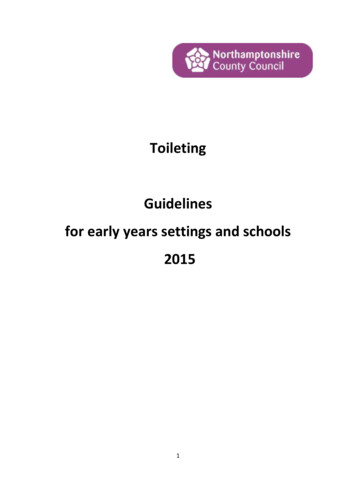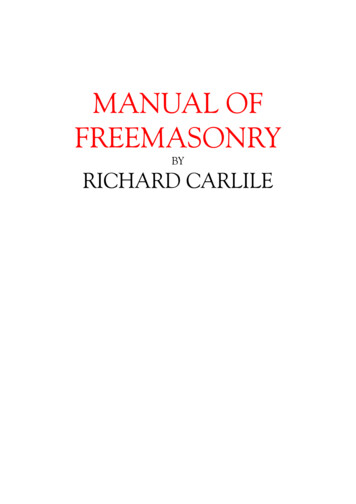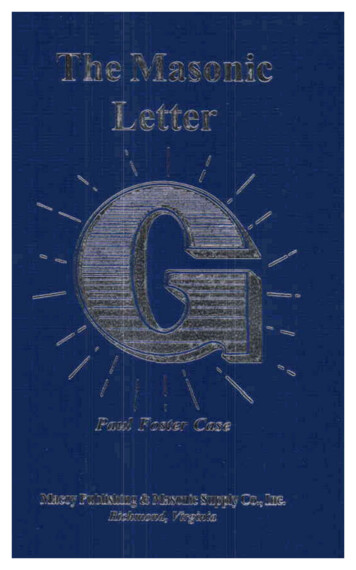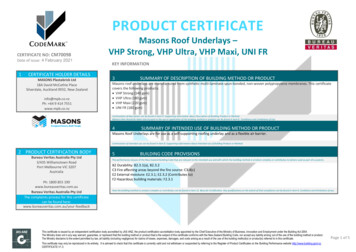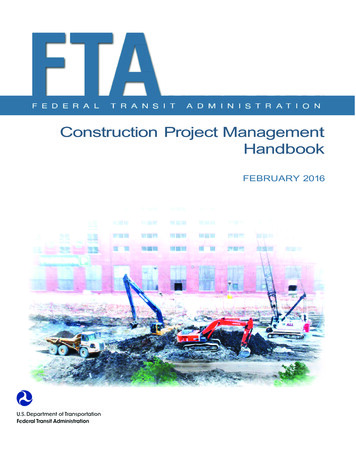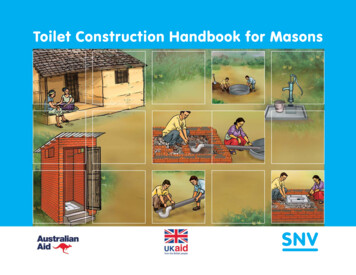
Transcription
Toilet Construction Handbook for Masons1
Published DatePublished ByContentDesign and LayoutIllustration:::::June 2017SNV Nepal, Jawalakhel, LalitpurKailash Sharma (SNV Nepal)Top of Mind Pvt. Ltd.Sovit Baniya (Top of Mind Pvt. Ltd.)
Table of Contents1. IntroductionRationaleTarget audienceToilet 4Basis for toilet selection2. Tools and materials3. Site selection and orientation4. Construction of single-pit, offset, water-seal toilet4.14.24.34.44.54.64.74.84.94.10Layout and schematicFeaturesRequired estimation (up to plinth level)Pit constructionSlab coverPlinth constructionPipe and siphon fittingSiphon settingPan and siphon settingFloor construction444456778891011121314155. Construction of double-pit, offset, water-seal toilet166. Toilet with septic tank and soak pit175.15.26.16.26.36.46.56.6Distance between two pitsPipe joiningSchematic and layoutSize of the septic tankBrick wall constructionPipe connection and wall finishingSeptic tank cover slabsSoak pit construction7. Super structures7.17.2Dimension of super structureType of super structure8. ReferencesToilet Construction Handbook for Masons161617171818191920202123
1. IntroductionRationaleWith the aim of becoming an “Open Defecation Free” country bythe end of 2017, Nepal has seen a rapid increase in the constructionof toilets in recent years. These toilets generally comply with thenational definition of an improved toilet and have a permanentstructure up to the plinth level. Assessments of toilets havehowever shown that quality of construction remains a challengein all parts of the country which leads to leakages, smell, anddisrepair. Poorly constructed toilets may also be uncomfortable forthe users. A key factor of poor quality is the inadequate technicalknowledge of masons, many of whom have developed their ownskills through experience.The aim of this handbook is to provide technical details on the keysteps of toilet construction which can guide masons on makingquality toilets and upgrading existing toilets. The handbook hasbeen finalised after testing with masons in three terai districts(Siraha, Mahottari, and Sarlahi).Target audiencehave a permanent structure up to the plinth level. Therefore, alltoilet options in this handbook meet these criteria, are durable,and minimise the risk of disease transmission.In Nepal the following, options are considered as animproved toilet:a. Flush or pour-flush to: Piped sewer system Septic tank system A pitb. Ventilated improved pit (VIP) toiletBasis for toilet selectionThere are a number of factors that play an important role inselecting a desired toilet. Some key factors are as follows:The intended primary audience of this book is masons andsanitation technicians who are engaged in toilet construction.Although the pit construction is oriented toward the ringedstructures found in the terai, other parts of construction (pan andpipe, superstructure etc.) also respond to the typical mistakesfound in the hill and mountain areas. This handbook can also beused by social mobilisers and field supervisors to monitor qualityof construction. Cost/affordability Water availability Geological condition: soil type, water table Cleansing habit Space availability Social norms, cultural habit Faecal sludge emptying systemsToilet Availability of sanitation products and servicesThe Sanitation and Hygiene Master Plan (NSHMP 2011) has definedan improved toilet as one that hygienically separates humanexcreta from human contact. It further recommends all toilets to4Toilet Construction Handbook for Masons
2. Tools and materialsTools and equipmentMaterialsSandMeasuring tapeRingLevel pipeShovelPick axePlum lineTrowelRing coverCementSpadeHand floatHammerBucketFine sieveToilet Construction Handbook for MasonsSquatting pan setGravelMugCement pan5BricksHDPE pipe
3. Site selection and orientationb. Distance to groundwaterMinimum 5’a. Location’mmuniMi33 Toilet should be constructed close to the house for easy accessby all members Minimum vertical distance (safety gap) between bottomof pit and groundwater table should be 5 ft Horizontal distance between toilet pit and groundwater source(e.g. well) should be minimum 33 ft In case groundwater source is less than 33 ft away, the inner sideof the pit wall should be sealedc. Orientation Toilet door should not face directly towards the house, courtyard, or public path so that female members can use the toilet withprivacy (not illustrated)6Toilet Construction Handbook for Masons
4. Construction of single-pit, offset, water-seal toilet6’7’4.1 Layout and schematicRemovable slabfor pit emptyingGround levelWater-seal pan4’4’Pipe slopes towards pit(min. slope 1:15)Concrete ring(32” ø x 16”)3’8”Toilet Construction Handbook for Masons7
4.2 FeaturesSuitability: Low groundwater tableAdvantageDisadvantageOdour freeWater is needed for flushing excretaEasy to cleanSkilled mason is needed for constructionEasy access to pit for faecal sludge emptyingRisk of ground or surface water contamination if constructed near waterpointsPossible to upgrade to a double-pit, offset toiletRequires more land for construction than a direct pit toiletFaecal sludge needs to be emptied from pit every 3-5 years4.3 Required estimation (up to plinth level)SNItemsUnitQty.A.Materials1Concrete ring (32” ø x 16”)Nos.32Ring coverNos.13CementBag of 50 kg24SandCement bag105GravelCement bag36BrickNos.2807Pan with siphonSet18HDPE pipe 4”ft3B.Human resources1Skilled let Construction Handbook for Masons
4.4 Pit constructiona. Excavationb. Ring laying4’3’ Diameter of excavated pit should be 4 in. bigger than the ringdiameter (i.e. 2 in. gap between ring and pit wall) Depth of excavated pit depends on the number of rings usedand the height of the groundwater table (maintain minimumsafety gap) For standard-size concrete rings (32” ø x 16”) and a 3-ring pit,pit dimensions should be:Diameter: 3 ftDepth: 4 ft A layer of sand and fine gravel should be spread across thebottom of the pit to help disperse flowToilet Construction Handbook for Masons9 Rings should be laid one above another carefully Top ring should extend at least 8 in. above the ground toprevent surface water from entering the pit Gap between ring and pit should be filled with sand. It will soakwater from pit (not illustrated) In raised pit latrines, any rings fully above the ground shouldbe sealed with cement sand mortar (not illustrated)
4.5 Slab covera. Sealing of slabb. Soil fillingSealed Top ring should be covered by a RCC slab having twohandles (for ease of lifting at the time of emptying) Pit should be covered by soil to minimum above thehandles of RCC slab for safety purpose Joint of ring and RCC slab should be sealed by usingmixture of clay, dung and husk to prevent waterfrom entering inside the pit10Toilet Construction Handbook for Masons
4.6 Plinth construction(For a standard 4 ft x 3.5 ft super structure)b. Brick work up to plinth level4’4”1’a. Foundation1’4’10” Foundation size varies with size of super structure For standard-size super structure, size of foundationshould be:Base length: 4 ft 10 inBase width: 4 ft 4 in Width of foundation wall in the trench should be one full brick length;bricks should be laid above each other in a perpendicular manner Mortar of 1:5 cement, sand ratio should be used for wall construction After the foundation wall has set fully, the foundation wall should befilled up with clay or sand up to siphon level (not illustrated)Trench width : 1 ftTrench depth : 1 ftToilet Construction Handbook for Masons A 2 ft high foundation wall should be made starting at the base of thefoundation trench (i.e. up to 1 ft above ground level)11
4.7 Pipe and siphon fittinga. Pipe heating HDPE pipe should be heated to a point so that itcan regain its original shape after cooling down(overheating causes loss of elasticity)b. Pipe and siphon joining Immediately after heating, the siphon should be insertedinside the heated pipe Overlap joint of the pipe and siphon should be tied up withrope so that the pipe will grip the siphon tightly and minimiseany chance of leakage Cold water should be poured to cool the joint of the pipeand siphon, and help grip the siphon tightly (rope should beremoved afterwards)12Toilet Construction Handbook for Masons
4.8 Siphon settinga. Siphon placingb. Compacting side of siphon11” Siphon with pipe should be placed level on the sand/clayfilling of the foundation Siphon should be placed in the middle of the toilet widthwise and at least 11 in. far from the rear wall Slope of the pipe should be 1:15 (1 ft height for every 15ft length)Toilet Construction Handbook for Masons13 Water level should be checked inside the siphon (refer to 4.9a) Sand or clay should be filled up to the collar of the siphon andcompacted to prevent the siphon from tilting
4.9 Pan and siphon settinga. Pan settingb. Sealing of pan and siphon joint1”Sealed Pan should be placed on the collar of the siphon Minimum gap between the end of the pan and rear wall shouldbe 8 in The level of the pan should be checked by using a level pipe Water level should be maintained at least 1 in. above the bendof the siphon (refer to 4.9b) The correct position of the pan and siphon, and water level isshown in illustration belowAB Jute or cotton cloth dipped in cement paste should be placedinside the collar of the siphon to seal the joint of the pan andsiphon The level of the water inside the siphon should be checked again Final sealing should be done by using cement paste around thejoint of the pan and siphon above the jute or cotton cloth andleft to dry for 24 hoursC14Toilet Construction Handbook for Masons
4.1O Floor constructiona. Shoaling and leveling the floorb. Floor concreting and finishing After the joint seal has set, sand or clay should be filledunderneath and to the side of the pan and compacted Concrete of 1:2:4 cement, sand and gravel should be filled up tothe mark on the wooden frame and level with the pan Brick or stone shoaling should be done up to 2 in. below theheight of the pan The concrete should be compacted followed by smooth finishingwith a 1:1 cement, sand paste A wooden frame of 3-4 in. height should be fixed on theshoaling and outer surface of the brick wall The slope of the floor should be be maintained towards the panfrom all directions (as shown in illustration) A mark should be made on one corner of the wooden frameto determine the thickness of the PCC flooring; this shouldbe 0.5 in. above the pan A level pipe should be used to mark the other three cornersof the wooden frameToilet Construction Handbook for Masons15
5. Construction of double-pit, offset, water-seal toiletAll the construction processes from pit excavation to floor construction are the same as for a single-pit, offset toilet. Major aspects that needto be considered in the construction of a double-pit toilet are: the distance between the pits and pipe joints for using soak pits alternatively.5.1 Distance between two pits5.2 Pipe joining3’ The distance between two pits should be at least3 ft to prevent water from one pit infiltrating intothe second pit A Y or tee joint fitting should be used at the outlet of the sub-structure toconnect pipes to the soak pits; the connection should be fixed using cottonor jute cloth with cement paste as an adhesive The length of the pipe from the Y or tee joint of the sub-structure up toeach soak pit should be at least 3 ft A pipe should be connected from the outlet joint to only one pit at a timeand the second outlet should be plugged by a joint cap After the first pit has filled up, the pipe to this soak pit should be removedand fixed with an adhesive cloth to the outlet for the second pit; the jointcap is then placed on the outlet for the first pit16Toilet Construction Handbook for Masons
6. Toilet with septic tank and soak pit6.1 Schematic and layout6.2 Size of the septic tankA septic tank should have minimum two chambers for effectiveseparation of solids and reduction in pollutants. The size of theseptic tank varies with the number of users.3’Concrete ring (32” ø x 16”)W.C.4’5’Half brick wallToilet Construction Handbook for Masons17No ofusersLengthWidthDepth55 ft3 ft3 ft 3 in106 ft 6 in3 ft4 ft 6 in156 ft 6 in3 ft8 ft 6 in207 ft 6 in3 ft 6 in8 ft 6 in
6.3 Brick wall construction Shoaling should be done on the floor of the septic tankusing brick or stone Mortar of 1:5 cement, sand ratio should be used for wallconstruction Concrete of 1:2:4 cement, sand and gravel mixture and 2in. thickness should be filled on the floor The gap in the baffle wall should be two-thirds from thebottom of the tank6.4 Pipe connection and wall finishing The inlet and outlet pipes should be connected to the septictank using tee joints (to prevent scum layer from exiting withthe effluent) The height of the inlet pipe should be 2 in. above the outletpipe The outlet pipe should be connected to a soak pit The walls and floor of the septic tank should be plasteredusing 1:4 cement, sand mortar from the inside18Toilet Construction Handbook for Masons
6.5 Septic tank cover slabs6.6 Soak pit construction The slab covers of the septic tank should be 1 in. largerthan the dimensions of the tank The soak pit can be lined with concrete rings (not plasteredfrom the inside) or dry brick wall and left empty from inside(optional to fill with coarse rocks or gravel or brick bats) Each chamber should have a separate slab cover andmanhole Slab covers should be casted using reinforced concrete of1:2:4 cement, sand and gravel mixtureToilet Construction Handbook for Masons19 Alternatively, the pit can be left unlined and filled with coarserocks and gravel below the pipe level to prevent it from collapsing The minimum vertical distance between the bottom of the pitand groundwater table should be 5 ft to prevent groundwatercontamination
7. Super structures7.1 Dimension of super structureTwo types of super structures can be built to house the toilet permanent or temporary. The standard size of a super structureis as follows: Floor size (inside toilet): length 3 ft 4 in, width 2 ft 10 in Toilet size (outside)*: length 4 ft, width 3 ft 6 in Wall height: front 7 ft, rear 6 ft2’6” Door size: height 6 ft, width 2 ft 6 in Height of door latch: 2 ft 6 in (should be easily reachablefor children and people with disabilities) Height of ventilation window from floor: 5 ft from floor6’7’5’ Size of ventilation window: width 1 ft, height 8 in Height of vent pipe: 6 in above the highest roof point (notshown) Light fixture is recommended inside3’6”4’*Outside dimensions of toilet floor will vary depending on thethickness of the material used to construct the toilet wall.20Toilet Construction Handbook for Masons
7.2 Type of super structureSuper structure: wall and roof materialsStructure type IllustrationMaterial detailsAdvantageDisadvantageStraw house Wall and roofmaterials:straw/thatch Low cost Temporary structure Local materials Needs regular repair Skilled mason not needed forconstruction Maintaining privacy is difficultif not constructed properly Ventilation can be created at thetop of the wall by making a spacebetween the roof and the wall Placing door latch might bedifficult Wall materials:bamboo Low cost Temporary structure Roof materials:straw/thatch Local materials Skilled mason not needed forconstruction Roof material needs to bereplaced periodicallyBamboo house Ventilation can be created at thetop of the wall by making a spacebetween the roof and the wall Needs regular repair Maintaining privacy is difficultif bamboo is not fixedproperly Can be easily upgraded to clay- orcement- plastered wall structureClay-plasteredhouse Wall materials:bamboo orstraw wallplastered withclay on bothsides Roof materials:straw/thatchToilet Construction Handbook for Masons21 Low cost Temporary structure Local materials Roof material needs to bereplaced periodically Skilled mason not needed forconstruction Privacy can be maintained Needs regular repair- clay willerode through contact withwater Wall may collapse if notconstructed properly
Zinc sheetWooden house Wall and roofmaterials: CGIsheet Semi-permanent structure Wall materials:wood Semi-permanent structure Roof materials:CGI sheetStone houseBrick house Privacy can be maintained Privacy can be maintained Semi-skilled mason needed forconstruction Toilet becomes hot during thesummer and noisy during themonsoon rain Semi-skilled mason needed forconstruction Maintaining privacy is difficultif wood is not fixed properly Wall materials:stone Permanent structure Roof materials:CGI sheet Maintenance is easy Costly Permanent structure Skilled mason needed forconstruction Wall materials:brick Roof materials:CGI sheet Privacy can be maintained Can use both clay and cementmortar for laying bricks Skilled mason needed forconstruction Costly Privacy can be maintained Maintenance is easy22Toilet Construction Handbook for Masons
8. References1. DWSS. Technical options for large scale promotion in rural and semi-urban communities of Nepal.(Vol. 1, 2, & 3). Nepal2. DWSS. Typical latrine drawing. Environmental Sanitary and Disaster Management Section. Nepal3. DWSS (2069 B.S). Resource book for masons on household toilet construction (Nepali language).Environmental Sanitation Section4. NEWAH (2067 B.S). Appropriate drawings and types of toilet for school and household at communitylevel (Nepali language). Nepal5. DWSS (2017). Household toilet options for the terai. National Water Supply and Sanitation TrainingCenter, DWSS, Nepal6. https://www.sswm.info/content/soak-pitsToilet Construction Handbook for Masons23
24
Odour free Water is needed for flushing excreta Easy to clean Skilled mason is needed for construction Easy access to pit for faecal sludge emptying Risk of ground or surface water contamination if constructed near water points Possible to upgrade to a double-pit, offset toilet Require
